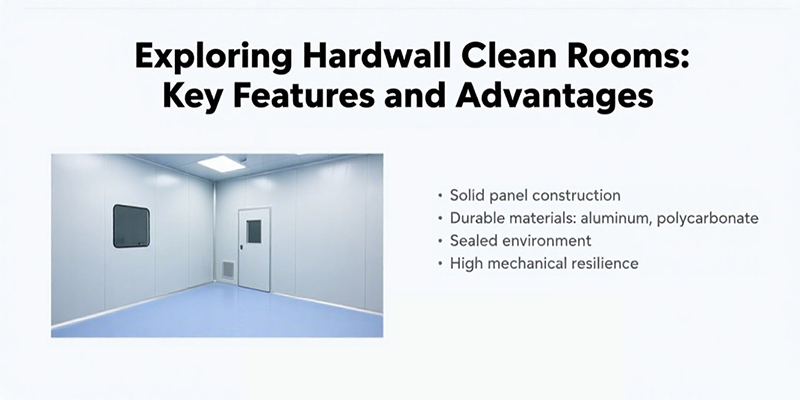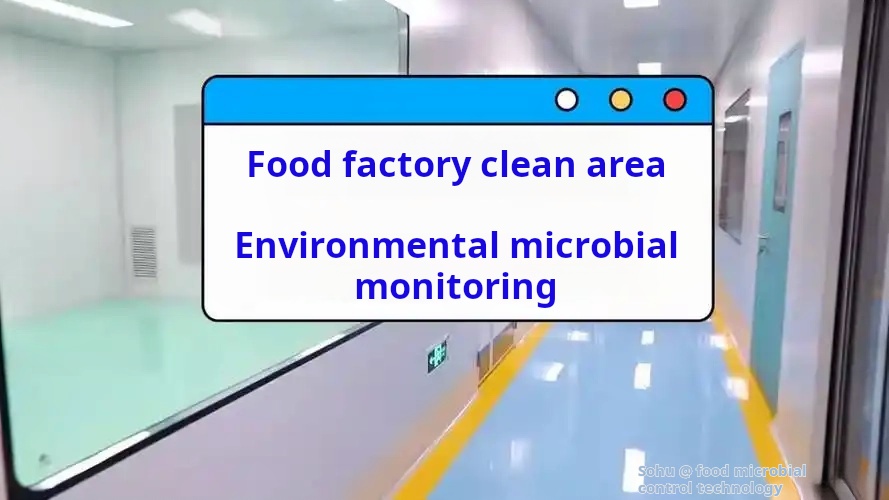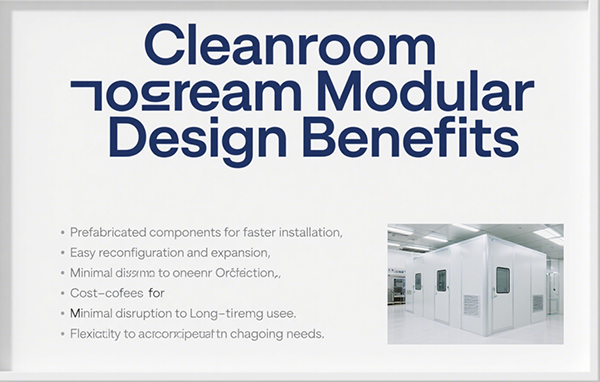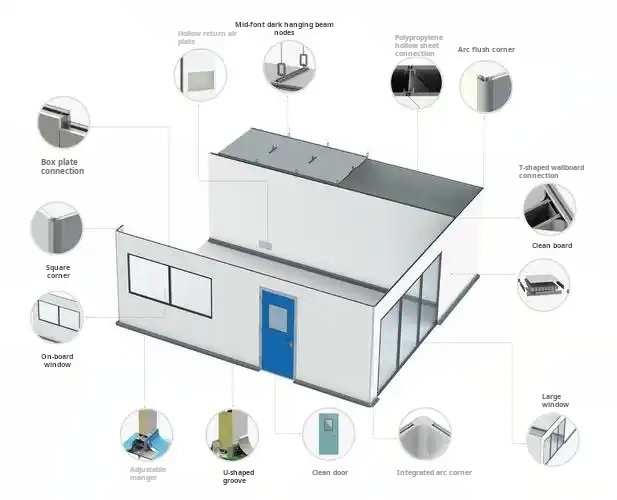Exploring hardwall Clean rooms: Key Features and Advantages
Essential Environments for Impeccable Cleanliness
Introduction
In industries requiring impeccable cleanliness and precision, hardwall Cleanrooms are essential. These environments, constructed with rigid walls, ensure minimal particulate contamination, supporting critical processes across multiple sectors. Ranging from pharmaceuticals to Semiconductors, hardwall Cleanrooms offer robust solutions for maintaining strict environmental controls.

Rigid Construction
Hardwall cleanrooms are built with solid panels or traditional walls, providing a stable and sealed environment. Unlike softwall Cleanrooms that rely on flexible vinyl sheets, hardwall structures leverage durable materials like aluminum or polycarbonate, enhancing mechanical resilience and longevity.
Hardwall Cleanroom
- Solid panel construction
- Durable materials: aluminum, polycarbonate
- Sealed environment
- High mechanical resilience
softwall Cleanroom
- Flexible vinyl sheets
- Less durable materials
- Less sealed environment
- Lower mechanical resilience
This rigid construction is vital for maintaining stability against external influences, ensuring operational integrity under high-demand conditions.
Material Variety
A key feature of hardwall cleanrooms is their diverse material selection. Options such as stainless steel, acrylic, and FRP offer varying benefits, from high corrosion resistance to excellent optical clarity.
| Material | Key Benefits | Industry Application |
|---|---|---|
| Stainless Steel | High corrosion resistance, hygiene properties | Pharmaceuticals, Medical Devices |
| Polycarbonate | High impact resistance, optical clarity | Semiconductors, Electronics |
| FRP (Fiberglass Reinforced Plastic) | Chemical resistance, durability | Biotechnology, Aerospace |
This range allows cleanrooms to be tailored to specific industry needs. For example, pharmaceuticals favor stainless steel for its hygiene properties, while semiconductors may opt for polycarbonate for its impact resistance.
Environmental Control
Hardwall cleanrooms excel in environmental control, managing temperature, humidity, and pressure differentials with precision. This level of control is critical for processes where even minor environmental changes can affect product quality.
Environmental Control Parameters
- Temperature: Typically maintained between 20-24°C (68-75°F)
- Humidity: Controlled between 30-50% relative humidity
- Pressure Differential: Positive pressure to prevent contamination ingress
- Airflow: Laminar or turbulent flow depending on cleanliness requirements
- Particle Filtration: HEPA or ULPA filters to remove airborne particles
Integration with advanced HVAC systems allows for consistent conditions, crucial for operations like biotechnology research, where stability is key to experimental integrity.
Contamination Prevention
The rigid construction of hardwall cleanrooms offers superior contamination prevention by sealing off airborne particles more effectively than softwall alternatives. This capability is essential for industries like medical device manufacturing, where any contamination can compromise product sterility.
Contamination Prevention Features
- Air-tight seals between panels
- HEPA/ULPA filtration systems
- Positive pressure differential design
- Anti-static surface finishes
- Controlled access protocols

Deiiang™, with product designer Deiiang Jason.peng, ensures designs meet stringent ISO cleanliness standards, safeguarding against environmental compromises.
Suitability for Applications
Hardwall cleanrooms are ideal for long-term applications in environments demanding strict cleanliness standards. Their design supports a range of ISO classifications, from ISO 5 to ISO 8, accommodating diverse industry needs.
ISO CleanRoom Classifications
| ISO Class | Particles ≤0.5μm / m³ | Typical Applications |
|---|---|---|
| ISO 5 | 3,520 | Semiconductor manufacturing, microelectronics |
| ISO 6 | 352,000 | Medical device assembly, pharmaceutical production |
| ISO 7 | 3,520,000 | Biotechnology labs, clean assembly areas |
In sectors like aerospace and life sciences, these cleanrooms ensure that processes are conducted in controlled settings, minimizing contamination risks while maximizing product safety and reliability.
Modularity
Many hardwall cleanrooms exhibit modular characteristics, allowing for prefabricated construction and easy reconfiguration. This modularity supports efficient adaptation to evolving production requirements without extensive redesign.
Modular Design Benefits
- Prefabricated components for faster installation
- Easy reconfiguration and expansion
- Minimal disruption to ongoing operations
- Cost-effective for long-term use
- Flexible to accommodate changing needs

For companies scaling production or shifting focus, modular cleanrooms offer a flexible framework that can be expanded or reconfigured with minimal disruption, making them cost-effective solutions over the long term.
Existing HVAC System Integration
Hardwall cleanrooms can integrate effectively with a building's existing HVAC systems. This integration is not only cost-effective but also ensures the maintenance of cleanliness standards without requiring extensive modifications to current infrastructures.
Integration Advantages
- Reduced installation costs
- Minimized construction downtime
- Seamless compatibility with existing systems
- Maintained environmental control consistency
- Compliance with international standards
With designs tailored by Deiiang™, these cleanrooms ensure seamless HVAC integration, supporting stable environmental controls essential for maintaining compliance with international standards.
Equipment Installation
Hardwall cleanrooms are designed to accommodate and incorporate different types of equipment efficiently. This compatibility ensures that operational workflows are optimized without compromising cleanliness standards.

Equipment Considerations
- Pre-designed mounting points
- Contamination-free installation protocols
- Compatibility with cleanroom materials
- Integration with air filtration systems
- Future-proof design for equipment upgrades
The consideration of equipment installation in the design phase, a focus for Deiiang Jason.peng, ensures that cleanrooms are equipped for seamless functionality, supporting both current and future technological needs.
Powerful Environmental Control
Hardwall cleanrooms provide comprehensive control over environmental variables, from static to particulate filtration and even achieving ISO 1 standards if necessary. This powerful control facilitates high-purity environments critical for sensitive applications.
Environmental Control Capabilities
| Control Aspect | Control Method | Application Example |
|---|---|---|
| Particulate Filtration | HEPA/ULPA filters | Semiconductor wafer production |
| Static Control | Anti-static flooring and materials | Microelectronics assembly |
| Temperature & Humidity | Precision HVAC systems | Biotechnology research labs |
This powerful control is critical for sensitive applications such as microelectronics fabrication, where even the smallest particle can lead to significant defects.
Hardwall Cleanroom Suitability
Hardwall cleanrooms are appropriate for various applications, from small cleanroom zones within existing facilities to full-scale ISO 5 and ISO 8 environments.
Medical Device Manufacturing
Ensures product sterility and compliance with regulatory standards.
Life Sciences Laboratories
Maintains controlled environments for research and development.
Semiconductor Plants
Prevents particle contamination in microchip production.
Pharmaceutical Production
Ensures hygienic conditions for drug manufacturing.
In these industries, maintaining a cleanroom environment is critical to operational success and product quality.
Conclusion
Hardwall cleanrooms are indispensable in maintaining controlled environments essential for industries requiring high levels of cleanliness and environmental control. With robust construction, a wide choice of materials, and flexible modular designs, they cater to diverse needs across sectors such as pharmaceuticals, electronics, and aerospace.
Their ability to integrate with existing systems and support powerful environmental controls makes them a preferred choice for long-term, high-demand applications. Supported by Deiiang™ and the expertise of industry professionals like Deiiang Jason.peng, these cleanrooms exemplify the convergence of robust design and precise functionality in supporting critical industrial operations.
Hardwall Clean Room Guide © 2025
 +86 18186671616
+86 18186671616 Jason@cleanroomequips.com
Jason@cleanroomequips.com
 MENU
MENU


